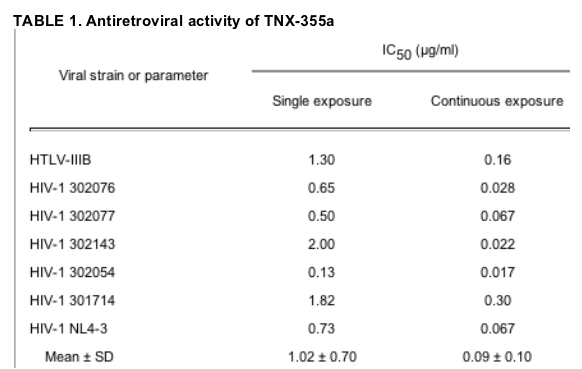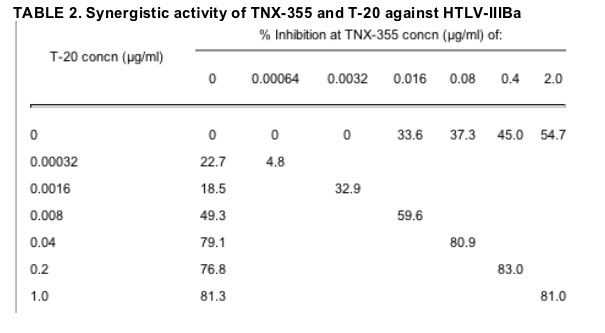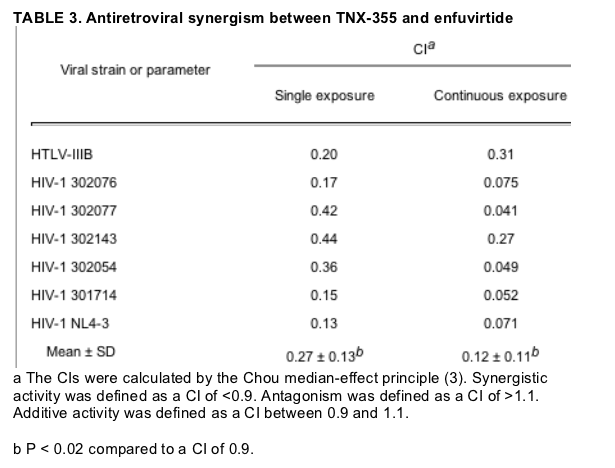| |
Anti-CD4 antibody TNX-355 synergistic with enfuvirtide against HIV-1
|
| |
| |
"....In the studies reported here, we have demonstrated that TNX-355 exhibits synergistic antiretroviral activity with enfuvirtide against both laboratory and clinical strains of HIV-1. That this monoclonal antibody acts synergistically with an agent acting at a distal step in the entry cascade supports the antiviral strategy of combining agents directed at sequential steps of the viral entry process. As chemokine receptor antagonists enter clinical development, three-way antiretroviral synergy efforts directed at the viral entry process should also be examined...."
2006-07-07
By Will Boggs, MD
NEW YORK (Reuters Health) - The humanized monoclonal anti-CD4 antibody TNX-355 is synergistic with the fusion inhibitor enfuvirtide (T-20) in blocking HIV-1 entry into target cells in vitro, according to a report in the June issue of Antimicrobial Agents and Chemotherapy.
"HIV entry is a multi-step process and offers several opportunities for using combinations of agents directed at different steps in this process," Dr. Robert T. Schooley from the University of California, San Diego, told Reuters Health.
Dr. Schooley and colleagues investigated the antiretroviral activity in vitro of TNX-355 and enfuvirtide against several HIV-1 strains.
The 50% inhibitory concentration of TNX-355 alone ranged from 0.13 to 2.0 micrograms/mL when the antibody was present for the initial 18 hours of the culture period, the authors report. Activity was significantly higher when antibody was replenished throughout the culture period.
As noted, TNX-355 also demonstrated significant synergistic antiretroviral activity with enfuvirtide in each experiment. "That this monoclonal antibody acts synergistically with an agent acting at a distal step in the entry cascade supports the antiviral strategy of combining agents directed at sequential steps of the viral entry process," the researchers conclude.
"As chemokine receptor antagonists enter clinical development, three-way antiretroviral synergy efforts directed at the viral entry process should also be examined," they suggest.
"The drug is entering phase III studies in which it will be combined with optimized background antiretroviral therapy to evaluate its utility in multiple combination regimens in vivo," Dr. Schooley added.
Antimicrob Agents Chemother 2006;50:2231-2233.
Synergistic In Vitro Antiretroviral Activity of a Humanized Monoclonal Anti-CD4 Antibody (TNX-355) and Enfuvirtide (T-20)
Antimicrobial Agents and Chemotherapy, June 2006, p. 2231-2233, Vol. 50, No. 6
Xing-Quan Zhang,1 Meredith Sorensen,2 Michael Fung,3 and Robert T. Schooley1*
University of California, San Diego, San Diego, California 92093,1 Dartmouth Medical School, Hanover, New Hampshire 03755,2 Tanox, Inc., Houston, Texas 770253
ABSTRACT
Recently, antiretroviral agents directed at several steps involved in viral entry have been shown to reduce viral replication in vitro and in vivo. We have demonstrated a high level of in vitro synergistic antiretroviral activity for two entry inhibitors that are directed at sequential steps in the entry process.
TEXT
Combination chemotherapy has had a profound effect on human immunodeficiency virus type 1 (HIV-1)-associated morbidity and mortality (8). Although there are now more than 20 approved antiretroviral chemotherapeutic agents, there is significant overlap in resistance patterns among these agents, effectively limiting the number of sequential antiretroviral regimens available to a given patient. Recent clinical trials have demonstrated that agents that either block the binding of HIV-1 to its chemokine coreceptors or prevent reconfiguration of the gp41 molecule significantly reduce the replication of HIV-1 in vivo (5, 6, 13, 14). These in vivo observations have been complemented by a series of in vitro observations that demonstrate that antiviral agents acting at several steps of the entry cascade exhibit substantial antiviral synergism (15, 16). TNX-355 (formerly hu5A8) is a humanized monoclonal antibody that binds to a unique epitope in domain 2 of the CD4 molecule that is involved in the conformational change required for entry into target cells following binding of the virus to the CD4 molecule (2, 7). We report here in vitro studies that demonstrate the synergistic activity of TNX-355 and enfuvirtide against HIV-1.
Peripheral blood mononuclear cells were isolated from HIV-1-uninfected donors by Ficoll-Hypaque density gradient centrifugation and grown in RPMI 1640 medium supplemented with 20% fetal calf serum, 5% interleukin-2, and 5 mg/ml phytohemagglutinin (R-3 medium). Three-day phytohemagglutinin blasts (2 x 106) were incubated with HIV-1 (100 50% tissue culture infective doses) and TNX-355, enfuvirtide, or both agents in 2.0 ml of medium overnight in 24-well tissue culture plates at 37C in a humidified 5% CO2 atmosphere. Peripheral blood mononuclear cells were washed three times in phosphate-buffered saline and resuspended in 2 ml of R-3 medium with replacement of the antiviral compound(s) being tested. HIV-1 p24 antigen production was assessed on days 4 and 7 of culture in cell-free supernatant fluid from each well by enzyme-linked immunosorbent assay (Beckman Coulter, Miami, FL). Fresh R-3 medium with appropriate antiviral compound concentrations replaced the 0.5 ml of supernatant removed for p24 assay on day 4. Primary HIV-1 isolates (302076, 302077, 302143, 302054, and 301714) were provided by the National Institutes of Health AIDS Reference Reagent Repository. Human T-cell lymphotropic virus strain IIIB (HTLV-IIIB) was provided by Robert Gallo (Institute of Human Virology, Baltimore, MD). TNX-355 (Tanox, Inc., Houston, TX) was used at concentrations of 2.0, 0.4, 0.08, 0.016, 0.0032, and 0.00064 mg/ml. Enfuvirtide (T-20; Trimeris, Inc., Durham, NC) was used at concentrations of 1.0, 0.2, 0.04, 0.008, 0.0016, and 0.00032 mg/ml. The 50% neutralization concentration (IC50) was calculated by using the Chou dose-effect equation (3). In synergy studies, virus was cultured in the presence of either a single drug or a combination of drugs in a checkerboard combination design of concentrations over the range outlined above. IC50s and combination index (CI) values were calculated by using the Chou dose-effect equation (3). By convention, a CI of <0.9 indicates synergy, 0.9 < CI < 1.1 indicates additive activity, and a CI of >1.1 indicates antagonism.
The antiviral activities of TNX-355 against a variety of laboratory-derived and clinical strains of HIV-1 ranged from 0.13 to 2.0 mg/ml when the antibody was present for only the initial 18 h of the culture period (Table 1). When the antibody was replenished throughout the culture period, the mean IC50s were significantly lower. Synergistic antiretroviral activity between TNX-355 and enfuvirtide was demonstrated in each experiment. The results of a representative experiment are presented in Table 2. Table 3 presents CIs calculated for each of the viral strains tested. In either scenario, the mean CI was significantly less than 0.9. CIs of 0.13 to 0.44 were observed when the two agents were included during the initial 18 h of tissue culture in checkerboard titrations against the viral strains tested. CIs indicated a greater degree of synergy when both agents were present throughout the culture period.

a Data represent the IC50s of TNX-355 against the indicated strains of HIV-1 in triplicate cultures harvested 7 days after viral challenge. Data in the single-exposure column represent the IC50s when the compound was added only at the time of viral challenge. Data in the continuous-exposure column demonstrate the IC50s when the compound was present throughout the culture period.

a TNX-355 IC50, 0.44 mg/ml; T-20 IC50, 0.011 mg/ml. CIs: 5A8/T-20, 0.023; T-20/5A8, 0.012. Data shown are from a representative experiment using the HTLV-IIIB strain of virus harvested after 4 days of incubation. Individual data points represent percent inhibition compared to untreated controls using means from three wells per drug combination. CIs were calculated by the Chou median-effect principle (3).

In a recently completed proof-of-concept study, a single dose of TNX-355 resulted in a mean plasma HIV-1 RNA decline of 1.25 log10 in a group of multidrug-experienced patients, including those for whom highly active antiretroviral therapy had failed (4). The 5A8 antibody does not result in the clearance of CD4 cells in vivo and does not measurably interfere with CD4 cell function (1, 9-12). This demonstration of the in vivo antiretroviral activity of TNX-355 raises the possibility that a novel step in the entry process may be exploited in the development of antiretroviral chemotherapeutic approaches that might be of particular utility in patients with viral strains that have developed resistance to antiviral drugs directed at the viral reverse transcriptase and/or serine protease. In the studies reported here, we have demonstrated that TNX-355 exhibits synergistic antiretroviral activity with enfuvirtide against both laboratory and clinical strains of HIV-1. That this monoclonal antibody acts synergistically with an agent acting at a distal step in the entry cascade supports the antiviral strategy of combining agents directed at sequential steps of the viral entry process. As chemokine receptor antagonists enter clinical development, three-way antiretroviral synergy efforts directed at the viral entry process should also be examined.
|
|
| |
| |
|
|
|